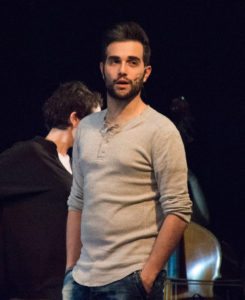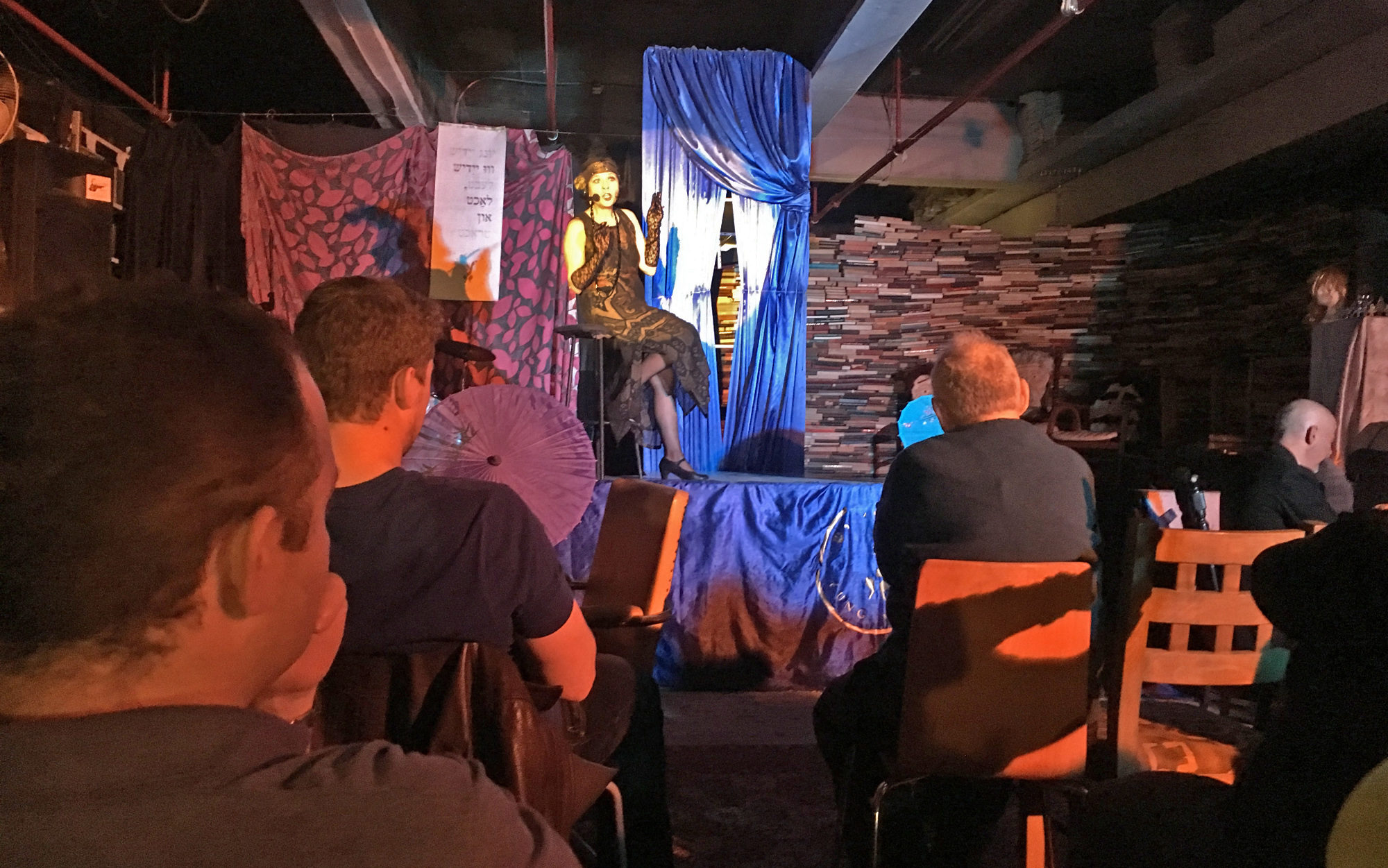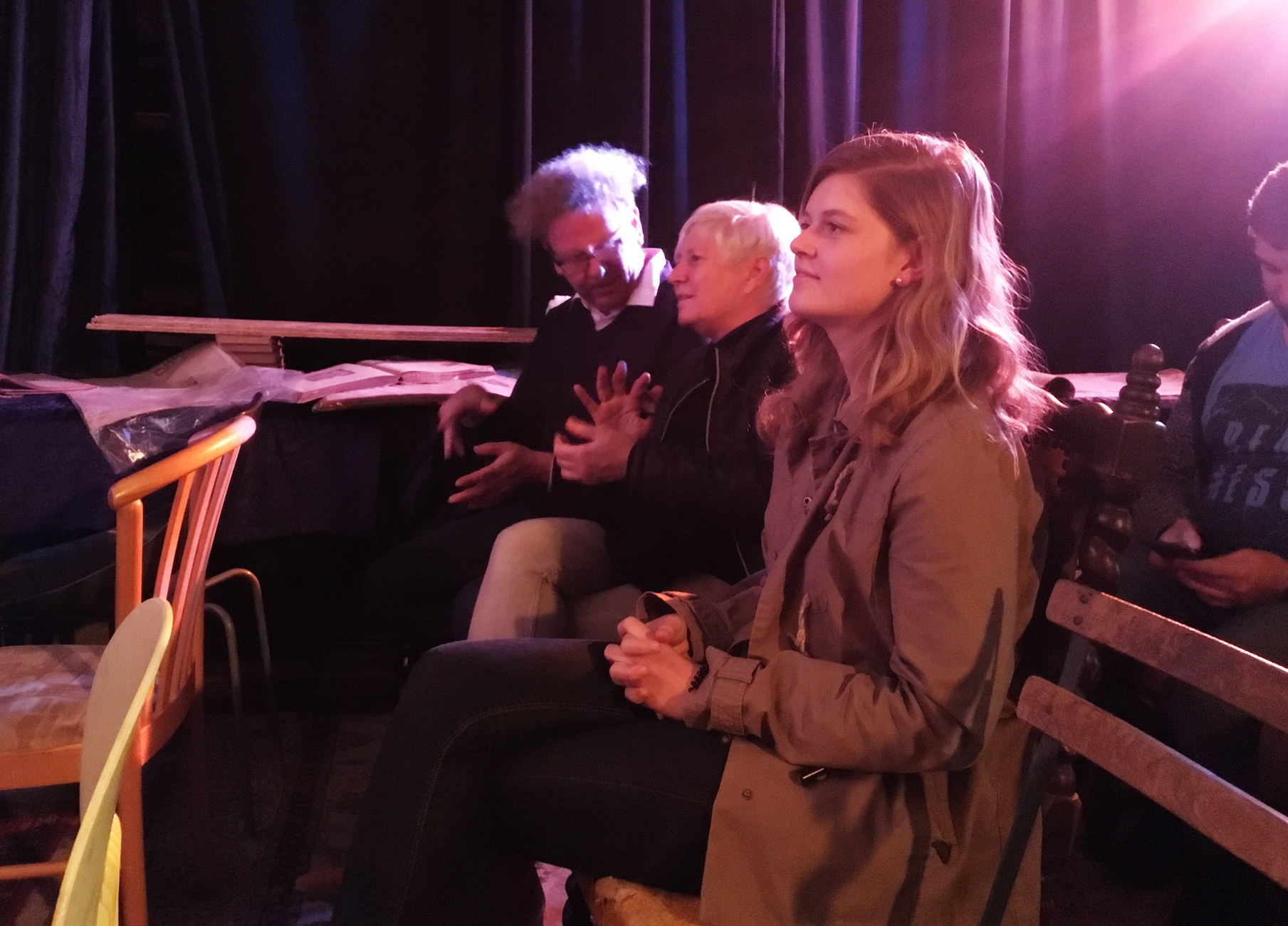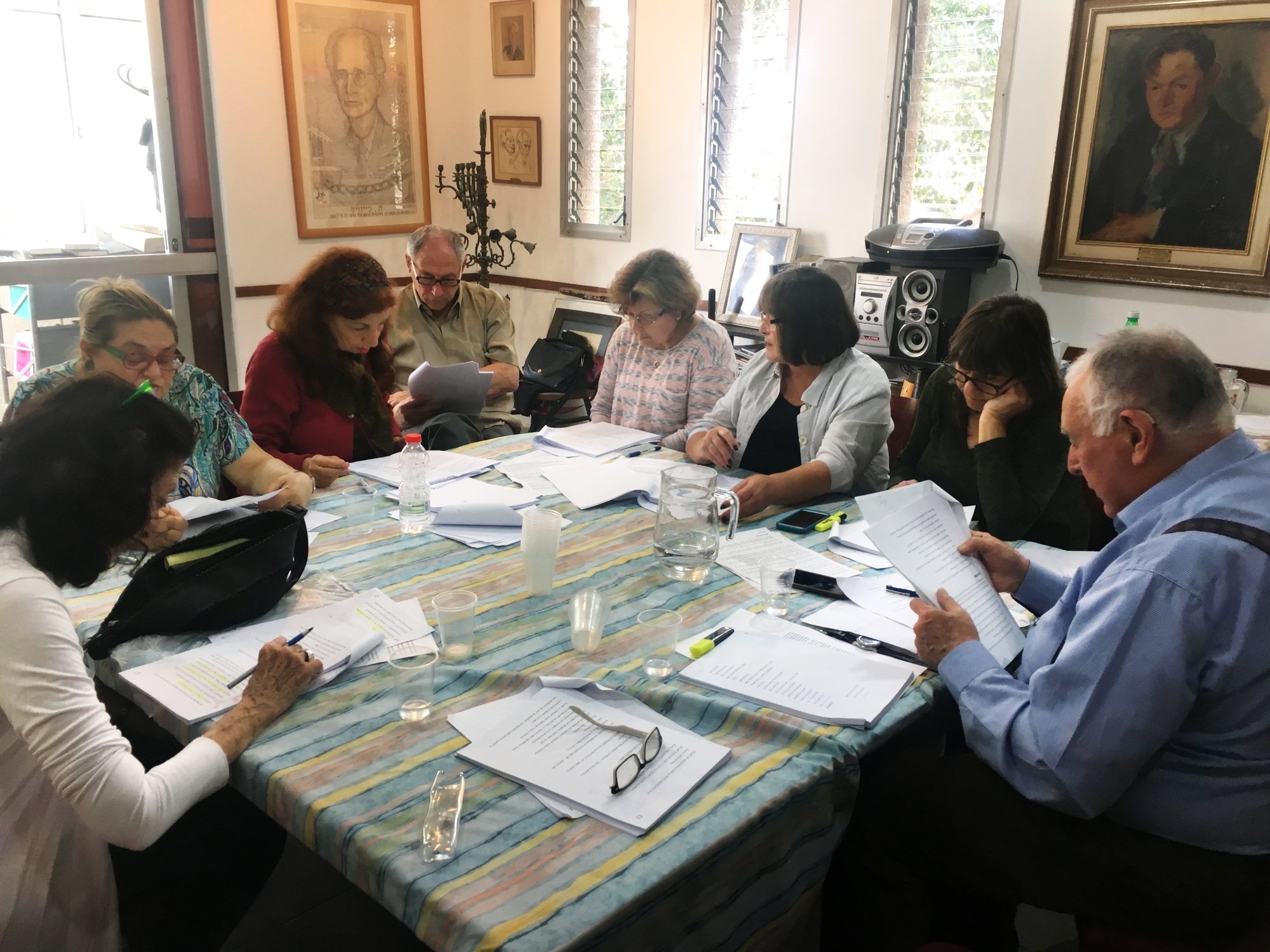Yiddish tries to find its home in the Jewish homeland
TEL AVIV — Sitting beside shelves of musty, tattered books, Denis Pechersky leaned forward in his chair, smiling warmly as he watched a jazz singer straight out of the 1920s croon her first mischievous notes of the evening.
The look of sheer contentment never left Pechersky’s face, though the 26-year-old from Moscow couldn’t understand what he was hearing — this language of his grandparents.
Ruth Levin interacts with the audience during a cabaret performance at YUNG YiDiSH in Tel Aviv on March 6, 2018. She introduced every song in English to facilitate comprehension of the “Yiddish extravaganza.”
Yiddish: the dialect of the Diaspora for nearly 1,000 years that was all but discarded in Israel during the push for a national Jewish state.
Hebrew, the victor in the language wars, dominates modern Israeli society. Yiddish, the loser, lingers in the fringes, in nooks like YUNG YiDiSH, a nonprofit organization aimed at perpetuating the culture.
“This atmosphere is very much like home,” said Pechersky, who’d discovered the performance on social media and was led into a bygone world of Eastern European Jewry.
And with that, Mendy Cahan, the founder of the eclectic space intended for everyone from secular to ultra-Orthodox Jews, had succeeded. He had generated a spark, revealing a rich history for another budding Yiddish enthusiast. It’s a modest goal, but Cahan, an actor and scholar, knows better than to attempt a full-scale Yiddish revival.
“I want it to live,” he said, his wisps of long grey hair flying in all directions against his black rockers’ jacket. “A language is very big and the Yiddish language has this way to survive like a salamander. It changes color.”
A once bright mama loshen, or mother tongue, of Jewish daily life turned dim after the Holocaust, in which thousands of Yiddish-speaking communities were exterminated. Yiddish —merging German, Hebrew, Aramaic, Slavic and Romance languages — is spoken among 250,000 Israelis today. Roughly the same number of Americans speaks Yiddish, written from right to left in Hebrew letters.
Still, there’s a sense of mirth — and solace — that’s synonymous with exploring YUNG YiDiSH, its archivist Avery Robinson explained.
“It’s just full of life,” he said.
On an unseasonably warm March evening, Pechersky and a dozen other individuals laughed at Ruth Levin’s dramatic Yiddish cabaret, a haphazard grouping of curtains and stacked books defining the eccentric stage setup. In a flapper-inspired ensemble, complete with a black-feathered cap and long lace gloves, Levin sang about enraptured and scorned lovers.
“Love is hell and only time cures our hearts,” she said in English before launching into Yiddish tunes, crafting a hybrid performance of an already hybridized language.
To encourage access to what’s become a more symbolic culture, Yiddish centers often use translations and niggunim — wordless melodies. Emotional connections far outweigh literal comprehension, though Lucie Gürtler found that she was able to decipher the songs.
A German exchange student at Tel Aviv University, Gürtler, 19, said a YUNG YiDiSH event in September, filled with spontaneous singing and dancing, had shaped her Israeli experience. She loved it so much that she returned for this “Yiddish extravaganza,” her visiting parents in tow.
Lucie Gürtler, originally from Germany but studying abroad at Tel Aviv University, awaits a jazz cabaret performance at YUNG YiDiSH on March 6, 2018. She brought her parents, DeHef Gürtler and Annette Greileweier, who were visiting Israel, along to the “Yiddish extravaganza.”
“I feel like Yiddish is a part of Israel and the Jewish people in general, and you don’t really see it here,” Gürtler said, describing the flavor of the language as German with Hebrew pronunciation. “This is something really traditional.”
With just one rectangular room to call its own, the warehouse-like setting of YUNG YiDiSH is edgy, rattling with an occasional bus passing through the New Central Bus Station below. Exposed ceiling beams and mismatched furniture accent the focal point of more than 50,000 books.
Cahan has the makings of a living library — a DNA of the Jewish people that’s evolved through time, he said, his hands curving into a double helix to illustrate periods of mutation and recovery.
“Yiddish puts me at ease with my historical depths — it is mine,” Cahan said. “Some of it is mine because it was my father’s, because it was my mother’s, because I grew up in it. I think Yiddish builds bridges where I can connect in a living way and then it seems a little less lost.”
For Dotan Amrani, whose parents are Moroccan and Yemenite, Yiddish was never his. The first time he heard it spoken among the religious sects in Jerusalem, “it sounded like nothing.”
Now, he’s an actor in Yiddishpiel, the only Yiddish theater in the country. He’s a connection for the older generation of Israelis yearning to simply hear the language of their childhood.

“Language is power all over the world,” Amrani said. “There is something very special to act in a language that is not your language.”
One recent night in Petah Tikva — a suburb 30 minutes east of Tel Aviv — he took the stage for the first-ever Yiddish rendition of “Only Fools Are Sad.” He wore secular clothes, an unbuttoned grey shirt and fitted black jeans, in a play about the Hasidic movement.
Jonathan Rozen, who played a rabbi journeying to the Land of Israel, had heard bits and pieces of Yiddish growing up. When offered an audition 10 years ago, Rozen challenged himself to master the language and practice pronunciations with his mother, an experienced speaker.
He’s discovered a hidden part of his family, though he said he doubts Yiddish is “going to be bigger.”
“I find myself in a dialogue with my grandfather, even though he’s not living. I wish in a way he could have seen me even just once perform in Yiddish,” Rozen said. “It’s a nice gain for me because Hebrew and the whole Israeli culture is in my blood every day.”
“Ay yai yai yai yai.
Ay yai yai yai yai.”
The young actors trilled repetitive notes throughout different vignettes, hands raised and fingers dancing in unrestrained excitement. Elderly audience members clapped and sang along to the beat — the contagious folk music conjuring an innate part of their Jewish upbringing.
Shoshana Vichter, 60, was beaming. She didn’t need the Russian or Hebrew subtitled screens placed slightly off stage — neither did most of her peers.
“I saw this play in Hebrew when I was a young girl,” Vichter said. “It is very exciting to see it in Yiddish.”
Sara Hochman, who’s enrolled in a local Yiddish course to improve her fluency, was thoughtful as she left the Heichal Hatarbut venue. Her own grandchildren, she said with a sense of resignation, have no interest in carrying on the language.
“I’m afraid it’s fading away,” Hochman said. “I think we are the last Mohicans. The last generation.”
As Yuval Rapaport, an actor and chief producer for Yiddishpiel, sees it, Yiddish will persist — as long as a certain fire is passed down from generation to generation. L’dor v’dor. It’s a Hebrew phrase, but it nevertheless embodies Rapaport’s conviction that Yiddish should thrive in only niche Israeli circles.
“I don’t think it will ever become mainstream — I hope it will not,” Rapaport said, adding that Hebrew, as Israel’s national language, is a signal of strength and freedom.
In the Yiddishpiel offices in Tel Aviv, Rapaport waved his hand dismissively, shrugging off the idea that Yiddish is “weak” or “crippled.”
A source of shame.
Yet that’s how Zionists once perceived this blended culture of the “old Jew,” which couldn’t have been expected to circulate in a new, sophisticated Jewish homeland. And so in Yiddish’s place, these pioneers resurrected ancient Hebrew, which itself had lost to spoken Aramaic — another Semitic language — around the fourth century B.C.E.
“Erasing such a big part of your culture sounds ridiculous to me,” Rapaport said. “I think we as secular Jews…lost something.”
It’s a familiar lament to Yaad Biran, who leads Yiddish-inspired tours in Jerusalem, Tel Aviv and Jaffa.
Many of his tour participants — also in the older age demographic — still feel the loss of their own parents, who commonly used Yiddish when they were growing up. They’ve walked the streets of Israel countless times before, Biran said, but now they’re searching for Yiddish to fuel their nostalgia.
“It wasn’t just a language that was spoken at home by your parents,” Biran will tell them. “It is a whole cultural world that you can access if you speak the language. It’s not just another culture. It’s your culture.”
Hana Wirth-Nesher, the director of a Yiddish institute at Tel Aviv University, offered a blunter assessment.
“It exists in the religious community and it continues to exist there, but it doesn’t generate any new cultural product,” she said.
Wirth-Nesher doesn’t see this as a tragedy because she knows Yiddish can be “cool” once again among the 20-year-olds — and even the 40-year-olds. It can “remain as a cultural force and as a source of enrichment for young people who want to learn it,” she said.
It’s a cause to which Daniel Galay, the chairman of a Yiddish publishing house and cultural center, has devoted his life’s work.
He said he owes it to the Association of Yiddish Writers and Journalists in Israel, which was founded in 1928 amid a government ban on all non-Hebrew theater performances. And he owes it to his children, who didn’t receive the same Ashkenazi upbringing in Israel that Galay did in Argentina, where more than 100,000 Eastern European Jews fled in the face of rising anti-Semitism.
“It can live in Israel,” Galay said. “It can be significant for the Israeli society.”
But as self-proclaimed Yiddish activists gathered at the Leyvik House to read one of Galay’s original plays on a Friday morning, there was tension — an uncertainty in how far their efforts would truly take them.
Yiddish enthusiasts gather at the Leyvik House in Tel Aviv to read an original play by Daniel Galay, right, on March 9, 2018. Bickering and amusement often arose in using the correct Yiddish pronunciations.
Roni Cohen, a 30-year-old Ph.D. student, stood out as a younger participant surrounded by a handful of older native speakers. To Bella Bryks-Klein, who runs the Israel-based Workmen’s Circle, or Arbeter-ring, this is at the heart of the dilemma.
“I would want to attract the younger generation,” Bryks-Klein said, “but…the natural-born Yiddish speaker who was from Eastern Europe, the Holocaust survivor — that generation is going. It’s gone.”
This is “Jewish,” or the literal translation of “Yiddish,” as another participant referred to it: A way of life — a way of speaking — that managed to unite a people who were expelled from Israel and scattered across the globe for a millennia.
Cohen’s philosophy is that languages and cultures don’t ever really die.
“I don’t believe in it,” he said, trailing his hands along post-World War II memoirs in a makeshift library. “I think cultures are changing forms all the time.”
Books themselves may be inaccessible, Cohen said, but there’s a steady growth of digitized translations. Bryks-Klein is learning to become flexible too, sprinkling Hebrew into otherwise “pure Yiddish” lectures.
She admitted there has to be an acceptance — however begrudging — that the future of Yiddish reaches beyond cultural beacons like the Shalom Aleichem House, where hundreds of retirement-age Israelis enroll in language courses.
It’s among the elusive youth, who sing and dance along to fresh klezmer music, the subversive sounds of traditional Ashkenazi Jewry, without grasping the meaning.
They’re building back a culture — a nachas, or joy, that Anat Aderet said she has witnessed for 23 years as a Yiddish programming coordinator at Bar-Ilan University. Sometimes, students bring along their Bubbies and their Zadies, and together they forge a link within an “enormous treasure,” Aderet said, her eyes welling up.
“Welcome home: Yiddish is for everyone,” she said. “There are no limits.”
After all, there’s a reason that nine miles away in Tel Aviv’s New Central Bus Station, Cahan established a “kaleidoscope” of YUNG, not old, YiDiSH. He’s lifted a veil, letting the foreign sights and sounds of the Yiddish experience — the Yiddish attitude — survive in the Jewish homeland.
“All this knowledge — it’s good that it’s there,” Cahan said. “This is a very real culture. This really, really was. It still is.”
~
~
Ladino, another Jewish language
TEL AVIV — Shmuel Refael has been charged with preserving a uniquely Jewish language that may soon be on the verge of extinction.
But with recently announced plans to establish the Israeli Academy of Judeo-Spanish Language, Refael can give the fusion of Hebrew and Spanish a fleeting chance.
“As a scholarly subject, it will be continued for many years,” Refael said. “As a spoken language in the Sephardic internal groups, I’m not sure.”
Ladino, as it’s commonly called, was spoken in the Jewish communities of Spain prior to the Inquisition. When the Jews were expelled in 1492, they took Espanyolit with them, subtly blending it with the tongues of their new homes — Arabic, Turkish and Greek, among others.
Sephardic Jews have a paradoxical relationship with Ladino, said Refael, who’s also the head of the Salti Institute for Ladino Studies at Bar-Ilan University.
Only about 400,000 Israelis can speak it fluently — or at the very least, cobble some phrases together. A Ladino knowledge test administered by the Institute between 2005 and 2009 produced “quite bad results,” Refael said, with an average score of just 50 percent among those who identified as proficient speakers.
More important to Refael, though, is the “huge interest” in the cultural phenomenon of Ladino.
“Judeo-Spanish is used today more as a sort of identity, as a tug, that the Sephardim are using to say, ‘Listen, we are Sephardim because we are the only Israeli group who still speaks the Spanish language,’” Refael said.
The Sephardim attend concerts and mingle to feel the pulse of Sefarad, or Spain, but oftentimes resort to conversations in Hebrew. Refael, who grew up in a Ladino-speaking household, has learned to accept these passive activities as small victories.
“To say if you cannot speak any more Judeo-Spanish or read or write texts in the language, please do not be involved — it would be stupidity,” he said. “It’s better than nothing.”
Ladino’s “dangerous decline” stems from the assimilation of Sephardic Jews into other cultures, Refael said, and the adoption of Hebrew as Israel’s national language.
It’s a similar tale for Yiddish, derived from Hebrew and German, which was spoken among Ashkenazi Jews in Eastern Europe for nearly 1,000 years. Unlike Ladino, Yiddish was highly stigmatized and perceived as a passive, embarrassing language by Zionists fighting for a Jewish homeland.
Yuval Rapaport, the chief producer of Yiddishpiel, the only Yiddish theater company in the country, readily embraces his roots — and the parallel legacy of the Sephardim.
“When I hear Ladino, I feel like I came home,” Rapaport said. “I don’t know why. I don’t know how. I can’t explain it.”
The new home for Ladino, approved by the Royal Spanish Academy in Madrid, will link Israel to 23 other centers across the Spanish-speaking globe. Joining forces with the National Authority for Ladino Culture, Refael said he hopes the academy opens sooner rather than later.
“They are very much concerned how the young generation — for instance, young Israeli children who grew up in this country — will learn about Judeo-Spanish,” he said.


